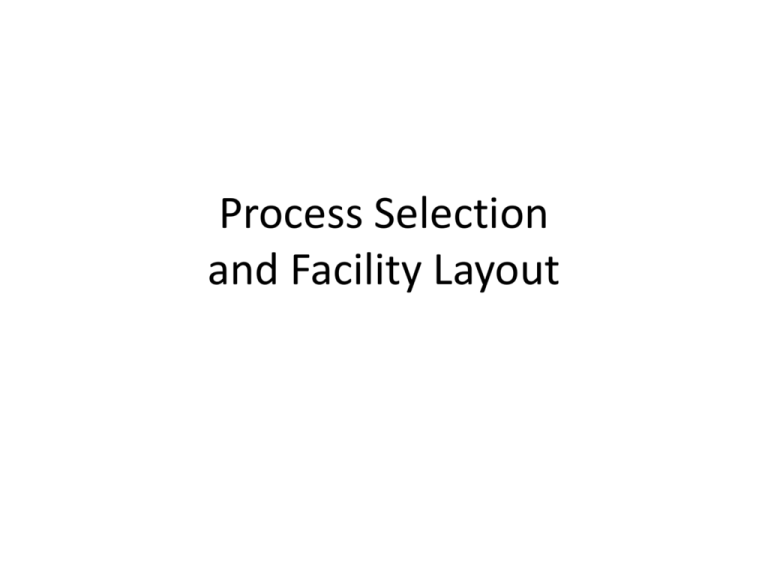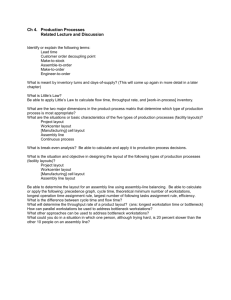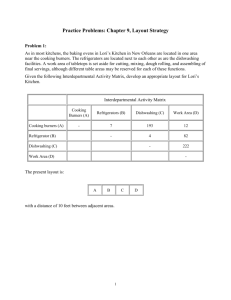Process Selection and Facility Layout
advertisement

Process Selection and Facility Layout Introduction • Process selection – Deciding on the way production of goods or services will be organized • Major implications – Capacity planning – Layout of facilities – Equipment – Design of work systems Process Selection and System Design Inputs Outputs Forecasting Facilities and Equipment Capacity Planning Product and Service Design Technological Change Layout Process Selection Work Design Process Strategy Key aspects of process strategy – Capital intensive – equipment/labor – Process flexibility – Adjust to changes – Design – Volume – Technology Process Selection • Variety – How much Batch • Flexibility – What degree • Volume – Expected output Job Shop Repetitive Continuous Process types Process types and volume • Job shop – Small scale, wide variety of goods • Batch – Moderate volume, flexible • Repetitive or assembly line – High volumes of standardized goods or services • Continuous – Very high volumes of non-discrete goods • Projects – Non-routine work, unique set ob objectives, limited timeframe and resources Product – Process Matrix The diagonal of the matrix represents the ideal choice of processing system for a given set of circumstances. Functions/activities affected by process choice Job variety, process flexibility, unit cost Volume Limited (not ongoing) Some examples (find the process type of each) Movie production Bakery Restaurant (non fast food) University Car repairing (car mechanic shop) Oil mining Producing office tools Veterinarian Project Batch Batch Batch Job shop Continuous Repetitive Job shop Product and service life cycles • Alongside the life cycle the sales and with it the production volume can change. • Thus managers must be aware of the change in the optimal processing system. (the necessity of change is highly dependent on the particular good or service) Example • Computer building shop in a garage (working for order only, one computer at a time for given Job shop purposes) • The shop hires some workers and producing some dozens of computers for one customer at a time Batch • Computer factory is established, creating large number of computer series Repetitive • The R&D function of the firm invents a new computer prototype Project Product/Service Profiling • Linking key product or service requirements to process capabilities. • Design the process with taking into consideration the following: – Range of products/services – Expected order size – Pricing – Expected frequency of changes in schedules etc. – Order-winning requirements –… Sustainable production • • • • Non-polluting Conserving natural resources & energy Economically efficient Safe and healthful for workers, communities and consumers • Socially and creaqtively rewarding for workers Automation of production and services • Automation: Machinery that has sensing and control devices that enables it to operate – Fixed automation – Programmable automation Advantages of automation • Low variability in performance and quality • Machines do not – get bored or distracted – go out on strike or ask for higher wages – lower variable costs Disadvantages • • • • • • Higher initial (investment) cost and Higher fixed costs Lower felxibility Higher skills needed Lower morale of human workforce Need for standardisation – Products – Processes – Equipment and materials etc. Automation • Computer-aided design and manufacturing systems (CAD/CAM) • Numerically controlled (NC) machines • Computerized numerical control (CNC) • Direct numerical control (DNC) • Robot: mechanical arm + power supply + controller • Manufacturing cell • Flexible manufacturing systems (FMS) • Computer-integrated manufacturing (CIM) Facilities Layout • Layout: the configuration of departments, work centers, and equipment, with particular emphasis on movement of work (customers or materials) through the system Importance of Layout Decisions • Requires substantial investments of money and effort • Involves long-term commitments • Has significant impact on cost and efficiency of short-term operations The Need for Layout Decisions • Inefficient operations • High (variable) cost • Bottlenecks • Changes in the design of products or services • The introduction of new products or services • Safety • Changes in environmental or other legal requirements • Changes in volume of output or mix of products • Changes in methods and equipment • Morale problems Objectives of facility layout Main: smooth flow of work, material and information Supporting objectives: Basic Layout Types • Product layouts • Process layouts • Fixed-Position layout • Combination layouts: – Cellular layout (& group technology) – Flexible manufacturing systems Basic Layout Types • Product layout – Layout that uses standardized processing operations to achieve smooth, rapid, high-volume flow • Process layout – Layout that can handle varied processing requirements • Fixed Position layout – Layout in which the product or project remains stationary, and workers, materials, and equipment are moved as needed Product Layout Used for Repetitive or Continuous Processing Advantages of Product Layout • • • • • • • High rate of output Low unit cost Labor specialization Low material handling cost High utilization of labor and equipment Established routing and scheduling Routing accounting and purchasing Disadvantages of Product Layout • Creates dull, repetitive jobs • Poorly skilled workers may not maintain equipment or quality of output • Fairly inflexible to changes in volume • Highly susceptible to shutdowns • Needs preventive maintenance • Individual incentive plans are impractical A U-Shaped Production Line Advantages/disadvantages of U-shaped lines • Shorter distances for workers & machines • Permits communication thus facilitates teamwork • More flexible work assignments • Optimal if the facility has the same entry and exit point • If lines are highly automated, there is no need for communication and travel • If entry points are on the opposite side as exit points • Noise and contamination factors are increased in the U-shape Process Layout Process Layout (functional) Dept. A Dept. C Dept. E Dept. B Dept. D Dept. F Used for Intermittent processing Job Shop or Batch Advantages of Process Layouts • Can handle a variety of processing requirements • Not particularly vulnerable to equipment failures • Equipment used is less costly • Possible to use individual incentive plans Disadvantages of Process Layouts • • • • • • In-process inventory costs can be high Challenging routing and scheduling Equipment utilization rates are low Material handling slow and inefficient Complexities often reduce span of supervision Special attention for each product or customer • Accounting and purchasing are more involved Fixed-position layouts • The product or project remains stationary and workers, materials, and equipment are moved as needed. • If weight, size, bulk, or some other factor makes it undesirable or extremely difficult to move the product. • E.g. firefighting, road-building, home-building, drilling for oil etc. Cellular Layouts • Cellular Production – Layout in which machines are grouped into a cell that can process items that have similar processing requirements • Group Technology – – The grouping into part families of items with similar design or manufacturing characteristics Makes cellular production much more effective Cellular layout Traditional process layout Functional vs. Cellular Layouts Dimension Functional Cellular Number of moves between departments many few Travel distances longer shorter Travel paths variable fixed Job waiting times greater shorter Throughput time higher lower Amount of work in process higher lower Supervision difficulty higher lower Scheduling complexity higher lower Equipment utilization lower higher Flexible manufacturing systems • FMS: a group of machnies designed to handle intermittent processing requirements and produce a variety of similar products. • CIM (Computer Integrated Manufacturing): a system of linking a broad range of manufacturing activities through an integrating computer system Service Layouts • Warehouse and storage layouts – Minimizing movement & picking time and cost • Retail layouts – Presence & influence of customers • Office layouts: – Information is computerized, image of openness Design Product Layouts: Line Balancing Line Balancing is the process of assigning tasks to workstations in such a way that the workstations have approximately equal time requirements. This way the idle time will be minimized, utilization will be maximized. Specialization: dividing work into elemental tasks that can be performed quickly and routinely. Cycle Time Cycle time is the maximum time allowed at each workstation to complete its set of tasks on a unit. tmax < Cycle time < ∑t Determine the Minimum Number of Workstations Required (rounded up to the next integer) Theoretical Nmin is not necessarily will be the Nactual. The latter is affected by other technical and practical considerations, too. Nmin ≤ Nactual Precedence Diagram A diagram that shows elemental tasks and their precedence requirements. 0.1 min. 1.0 min. a b c 0.7 min. A simplified precedence diagram d 0.5 min. e 0.2 min. Example 1: Assembly Line Balancing Assume that the desired output is 480 units per day. The facility is working 8 hours a day. The elemental tasks and their connections are shown on the previous slide. • Calculate the cycle time. • Calculate the minimum number of workstations. • Arrange the tasks to these workstations in the order of the greatest number of following tasks. Example 1 Solution Eligible Assign Task 1.0 0.9 0.2 a, c * c ** none*** a c - 0.9 0.2 2 1.0 b b 0.0 3 1.0 0.5 0.3 d e - d e - 0.5 0.3 Workstation 1 Time Remaining Revised Time Remaining Station Idle Time 0.2 * Tasks that have no predecessors. ** b is not eligible, because it needs more time than than the remaining. *** Every available task needs more time than 0.2. 0.0 0.3 Total: 0.5 Calculate Percent Idle Time and efficiency Efficiency %= 100 x (1 – Percentage of idle time) Line balancing procedure Line Balancing Heuristics • Assign tasks in order of most following tasks. – Count the number of tasks that follow • Assign tasks in order of task time. • Assign tasks in order of greatest positional weight. – Positional weight is the sum of each task’s time plus the times of all following tasks. Example 2 Working day is 8 hours and the desired output rate is 400 units per day. Draw the precedence diagram. Compute the cycle time & the minimum theoretical number of workstations required. Assign tasks to workstations according to the greatest number of following tasks. Tiebreaker: longest processing time goes first. Calculate Percent idle time & efficiency. Solution 2 a b c e d f g h CT = (8*60)/400= 1.2; Nmin = ∑ti / CT = 3.17 → 4 Work station Tasks assigned Idle time WS1 a,c,b 0 WS2 d,e 0.3 WS3 f 0.2 WS4 g,h 0.5 Percentage idle time = 1.0 / (4*1.2) = 20.83% Efficiency = 100 – 20.83 = 79.17% Other approaches • Paralell workstations • Cross-train workers (dynamic line balancing) • Mixed model line (more product on the same line) Parallel Workstations 1 min. 30/hr. 1 min. 30/hr. 2 min. 30/hr. 1 min. 30/hr. Bottleneck 30/hr. 1 min. 60/hr. 2 min. 30/hr. 1 min. 1 min. 30/hr. 2 min. Parallel Workstations 1 min. on average 30/hr. 60/hr. Thank you for your attention






